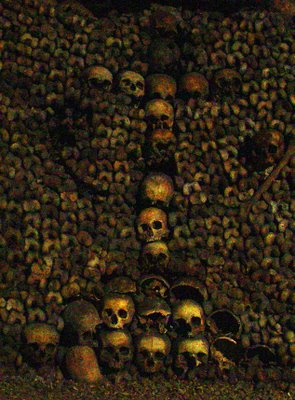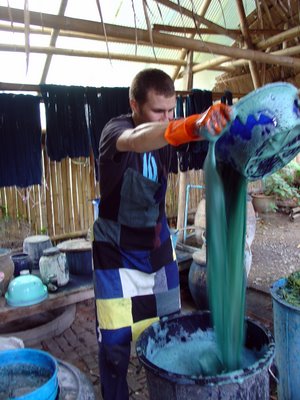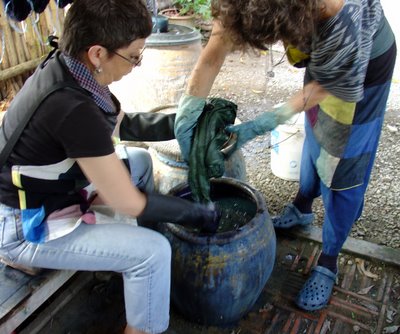31 October 2006
30 October 2006
29 October 2006
Yi Peng
On Saturday while we were eating lunch at The Kitchen (turns out its name in Thaimeans something like "Kitchen Full of Delicious Food") our friend Eh showed up and told us about the Yi Peng festival happening that evening in Mae Jo, just north of town. We'd heard about it, but weren't sure when it happened, so we called up our friend LB, and headed out. Yi Peng means "second moon" in Northern Thai Dialect, meaning that the festival happens on the second month of the Thai lunar year. Or the third. Or the twelfth. I haven't found a reliable source yet. It is the Lanna variant of Loi Krathong, the Thai festival of lights, and involves letting loose thousands of lantern balloons after a day of making merit with the Lord Buddha.
The next day after church we went to Wat Umong to see what the Monk Chat was like. For two hours each Sunday a British monk makes himself available for two hours for people to come and ask him questions. He seemed nice, and sincere, and had some good answers to some pretty dumb questions. There is an abundance of cheap Buddhism here in Thailand. The visit was LB's idea, and she was pretty disappointed. She made a good point about people who grow up with no religious community around them, so they end up searching for anything, and when they find something they don't know when to keep their mouth shut about their personal business.
So we went and looked at the fish pond instead. I was expecting a pond full of carp, but instead it was full of huge plecostomus and catfish, which people were feeding bread and food pellets.
Meanwhile, the catfish seem to have no trouble with their huge vacuum cleaner mouths. Almost makes you want to stick your hand in there.
Posted by
Dane
at
6:37 PM
5
comments
![]()
27 October 2006
Indigo Workshop

Ever since I started sewing, I've had an interest in natural dyes. A few weeks ago during the height of indigo season I attended a three day indigo workshop at Studio Naenna. The first day we went out into a neighboring field and cut several wheel barrow loads of indigo. We wrapped the leggy plants into bundles, then carefully filled about 8 garbage cans with 15 kilos worth of bundles and water to cover them. Then we placed a rock on top to keep them from floating up. As the bundles soaked over night the indigo pigment leached out of them, and on day 2 they were ready for "beating." Dane came on the second day to take the place of a sick participant, and we were glad for the extra muscle. In the "beating" process, you incorporate builders lime into the indigo-laced water by scooping and pouring the water back and forth in the can. The process is complete once the water has turned from a light green to a dark blue, and takes about 20 minutes of scooping and pouring!
The workshop instructor didn't let anything go to waste. She had pans to catch every little splash from the beating, and the bundles that we removed from the water previously were dried in the sun to be burned later. The ashes are used to make ash water, the mordant for the dye. After beating the fresh buckets we began to dye our fabrics using an existing dye pot. Good indigo dye pots are maintained in a very delicate balance. Before dying anything, you have to scoop out a cup full of the dye to add back to the pot at the end to replenish the exhausted dye. It's a bit like making yogurt or sourdough bread, with cultures and all. Dane and I dyed handwoven cotton, pictured above, that we purchased from the studio. The fabric is narrow because it's woven on a backstrap loom.

On day 3 we filtered the water that we beat the day before through a tightly woven cloth to collect the indigo paste that settles to the bottom. It's this paste combined with ash water, sugar, an indigo culture, and a little alcohol that makes the dye. In fact, the dye is a dark olive green instead of blue. The fabric turns blue once it hits the air and oxidizes. It's a really amazing process.
Posted by
Jami
at
4:56 AM
0
comments
![]()
Labels: craft, Jami's posts
26 October 2006
Art Walk
Tonight was the Art Walk here in Chiang Mai, organized by AS's friends Laura and Chadwick (once upon a time they lived in Prague and went around to museums, digging up old forgotten paintings from storage, and then painting copies of said paintings onto Chadwick's body). We met up with our friend Dave at Matoom Art Space (where I was showing two drawings), and wandered around to a few of the studios. It was fun, though the highlights may have been finding a stray copy of Art Forum to look at, and talking to Dave about religion. Actually though, there were some prints up at Matoom by a 4th year BFA student named Yong that were pretty nice--apocalyptic and nice. CMU has an exceptional printmaking department, with better facilities and more space than anywhere I've been in the states. We went to the MFA show about two weeks ago and were astounded. CMU offers only one MFA degree, and it's in printmaking. Frankly the most interesting work we've seen here so far has been out of that department.
Posted by
Dane
at
10:49 AM
0
comments
![]()
Labels: art, things you can buy
24 October 2006
I'm Just So Proud
Just today we finally made it to the top hit on Google when you search for "nofolete." I couldn't be happier.
Posted by
Dane
at
10:48 AM
0
comments
![]()
Labels: meta
23 October 2006
A Long Trip, and Two (Minor) Tragedies
On Saturday we took a ride into the mountains. Originally we had planned on visiting Wat Doi Suthep, but we'd already been there. Instead we walked around the market just down the hill from the Wat, looked at the fancy jade shop (no antique pieces, apparently they can't leave the country), and finally saw our first elephant. We left the states thinking there would be elephants everywhere, that there would be elephant parking at the supermarket. Not true. So we were very excited to see this little guy.Afterwards we decided to just keep driving up the mountain to see what was there. Our original plan was to go to Wat Doi Pui, but we kind of missed it, and ended up in a Hmong village on the other side of the mountain. We felt very out of place. It's not often that we feel rich. Practically never in fact. But in that village we felt privileged (in a negative sense) and useless. While we were there we admired their stocky little dogs, their corn mill, and I bought a small piece of applique.
We used up more than half our tank of gas getting that far out in the mountains, so we coasted all the way back down once we got off of the rutted and muddy unpaved roads.
Back in Chiang Mai, about a block from our house, traffic got bad. So I did what the Thai do and zipped up onto the sidewalk. Dumb idea. A girl stepped out of a phone booth with her back to us, and in my efforts not to hit her the bike fell over and slipped out from underneath me. I scraped my elbow, and Jami, fortunately, landed on top of me. Tragedy number two.
Tragedy number one, which occurred on Friday while I was cutting bamboo in the creek, involved our iPod falling out of my pocket, into the water and getting half buried by silt. When I pulled it out it was still on, but wouldn't turn off (water behind the click wheel). So I took it apart, took out the hard drive, disconnected the battery, and let it dry on the window sill for two days. It still works.
 For those of you who have been hankering to tear into one of those little white gumdrops, here's what they look like with the hard drive removed. I'm afraid these two "tragedies" only reinforce my feelings of privilege and uselessness. Maybe I should be grinding corn instead.
For those of you who have been hankering to tear into one of those little white gumdrops, here's what they look like with the hard drive removed. I'm afraid these two "tragedies" only reinforce my feelings of privilege and uselessness. Maybe I should be grinding corn instead.
Posted by
Dane
at
4:08 AM
0
comments
![]()
22 October 2006
Sweet and Sour Cat
Posted by
Jami
at
4:59 AM
1 comments
![]()
Labels: Jami's posts
16 October 2006
"Believe" Lanna Style: Or How Does a Horse Eat a Japanese Ceramicist: Or How to Eat a Bug Sober
Our design workshop began two weeks ago Monday, and ended last Saturday. It was hosted by the Chiang Mai University Faculty of Fine Art Craft and Design Service Center. The real name of the workshop ("Believe" Lanna Style International Workshop) was almost as long as the organization hosting it. Monday morning began with two excellent presentations by Professor Vithi Panitchapun covering Northern Thailand's history, culture, and visual culture (I have both power points saved as PDFs, they really are great, but it might not be that nice of me to upload them without permission, but if anyone is interested I could send them a copy). After Vithi's presentations he took us around Chiang Mai and Lampang for two days. It reminded us a bit of being in Italy, the tour bus rolling through the green hills, but tropical.
I found out about the workshop the night before it began thanks to our housemate AS. Apparently two designers had canceled, AS had been invited by a friend to participate, but decided that producing two prototypes in two weeks might not be his cup of tea. So he passed the buck to me (Jami and I both thank him for that), and I agreed to do it, not really knowing what I'd be getting into. Jami came with me the first day, just for the lecture, and since they were still one person shy of a quorum they begged her to join.
Day One:
We call this one, informally, the butterfly dance, though it could be of a bird or a bat. We don't know much about traditional Thai dance yet, but we have been told that the different hand positions have different meanings.
Day Two:
Masamichi Yoshiakawa was one of the artists participating in this workshop (he and his wife Chikako). He thought it might be neat to pet this little pony, which promptly took a chunk out of his arm. In this photo here, you can see a blurry Masamichi with his sleeve rolled up to keep it out of the wound.
Days three through twelve:
These days include our trip to Maesai, Jami's indigo work shop at Studio Naenna (which she will write a post about, I already uploaded a video about it), and lots of work on our projects. We began the workshop not quite sure what we were supposed to be doing (the idea for my first project came suddenly as a complete image about ten minutes before I began talking to my assistant to tell him what materials I'd need), and it wasn't made clear to us that we actually needed to make two prototypes until Friday.
 Jami's project involved tattooing male cabaret dancers.
Jami's project involved tattooing male cabaret dancers.Day Thirteen:
In the morning all the participants gave brief presentations of their projects and prior work. The westerners went last. I wish everyone had a website for me to refer you to, but the only ones that do are Dave Besseling and Ofer Zick (though if anyone knows of any more I'll happily take corrections). For dinner we headed to a fancy open air restaurant that specializes in Lanna cuisine. And then the fun began.
These lovely ladies (oops, laddies i mean) were probably a close second or third after the balloons and bugs. It kind of surprised us how common transvestitism is here in Thailand, but it has none of the stigma associated with it in the states. There's matriarchy for you. Everybody just gets along.











